Contents
Daffodils (Narcissus)
Daffodils (Narcissus) are spring-blooming bulbous perennials celebrated for their bright yellow flowers and trumpet-shaped blooms. One of the most popular types of flowers for early-season color, they are cherished in gardens around the world as a classic symbol of rebirth and the end of winter. These hardy plants emerge each spring from underground bulbs, often pushing through snow, to create a cheerful display that few other blooms can match. They deliver the season’s first splash of gold long before summer blooms like the sunflower make their appearance.
Gardeners prize daffodils for their reliability, easy care, and natural ability to multiply over time. A single bulb can produce a clump that returns year after year with minimal maintenance. Daffodils also have the benefit of being unpalatable to deer, rodents, and other wildlife, making them a trouble-free choice for many landscapes. With thousands of cultivars available-from tiny rock garden specimens to tall varieties with large trumpets-daffodils offer a range of colors (yellow, white, orange, pink, and bicolors) and bloom forms to brighten any spring garden.

🌱 Taxonomy and origin
Botanically, daffodils belong to the amaryllis family (Amaryllidaceae). The genus Narcissus comprises dozens of species, generally spring-flowering bulbs. In horticulture, all members of this genus are commonly referred to as “daffodils,” though some specific types carry other names (for example, the term “jonquil” refers to certain Narcissus types, such as Narcissus jonquilla, known for their fragrant clusters of blooms). Narcissus species are native to parts of Europe, North Africa, and western Asia, with a center of diversity in the Mediterranean region. Wild daffodils typically grow in meadows, woodlands, and rocky slopes in countries like Spain, Portugal, and Morocco, where they have adapted to mild, wet winters and dry summers.
Daffodils have a long history of cultivation. They were grown in ancient Greek and Roman times and later naturalized in northern Europe and beyond. The common wild daffodil (Narcissus pseudonarcissus), for instance, is native to Western Europe and became the basis for many classic yellow cultivars. Over the centuries, plant breeders have developed thousands of hybrid varieties from various Narcissus species. Today’s garden daffodils are classified into about a dozen divisions based on flower form (such as trumpet types, large-cupped, small-cupped, double flowers, jonquilla types, tazetta cluster-types, poeticus, etc.), reflecting the rich diversity achieved through breeding. The name “Narcissus” comes from Greek mythology – specifically the tale of Narcissus – and is also linked to the Greek word narke (“numbness”), an allusion to the plant’s toxic alkaloids and sometimes overpowering fragrance.
🌸 Bloom time
Daffodils are quintessential spring flowers, with most varieties blooming between late winter and mid-spring. In temperate climates, early-blooming daffodils can open as soon as February (even pushing through snow in late winter), while late-blooming varieties may not flower until April or even May. Peak bloom time for many classic daffodils is March through April. Each individual flower typically remains in bloom for about one to two weeks, especially in cool weather. By planting a selection of early-, mid-, and late-season cultivars, gardeners can enjoy a progression of daffodil blooms for well over a month.
In the landscape, daffodils often coincide with other spring bulbs, creating a vibrant display. Their flowering period overlaps nicely with tulips, hyacinths, and other early perennials, providing layers of color. As daffodil blossoms fade later in spring, other plants like irises and alliums begin to take the spotlight, ensuring continuous color in the garden. Indoors, certain types (such as paperwhite narcissus) can even be forced to bloom in winter, but in outdoor gardens daffodils reliably herald the arrival of spring each year.
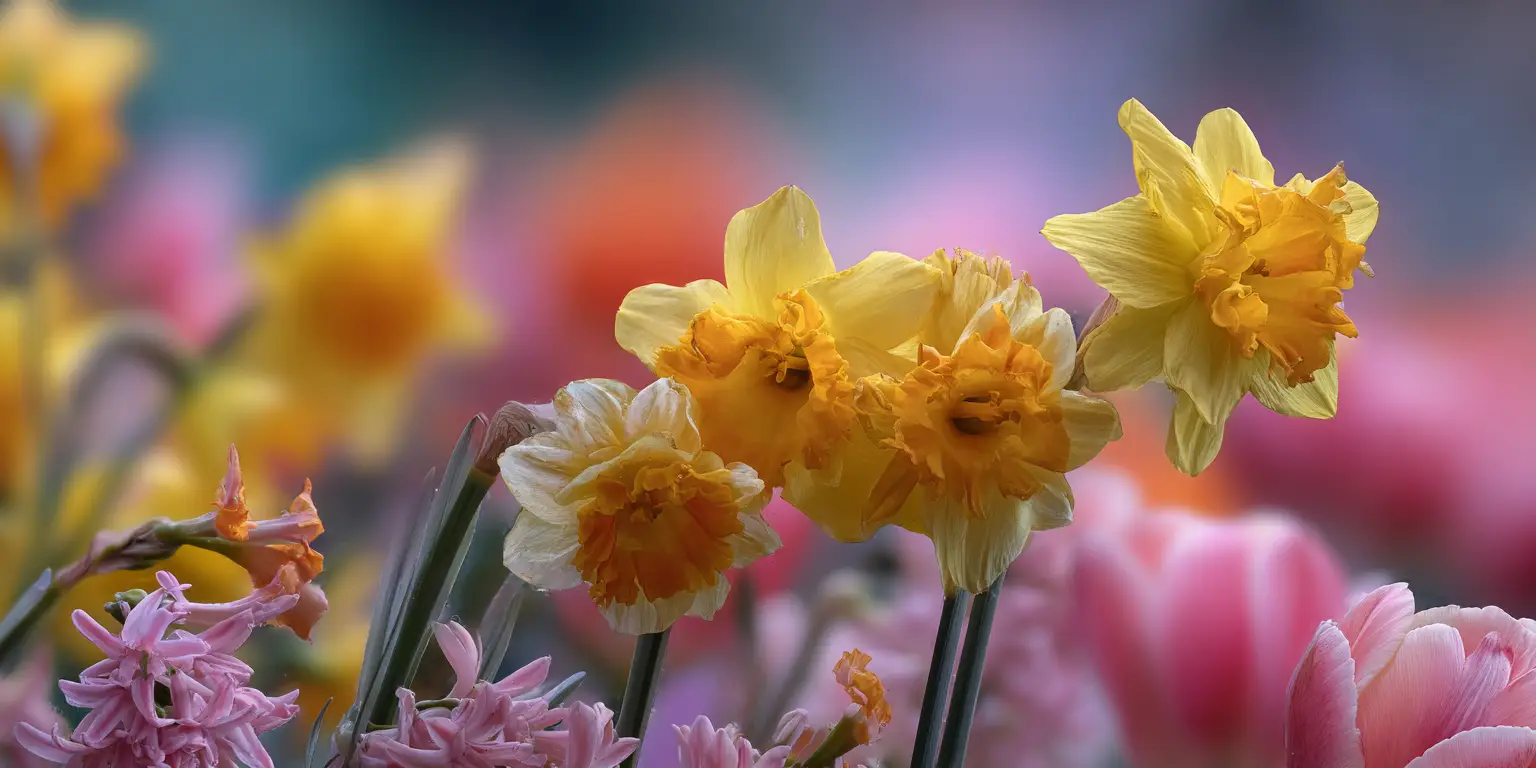
📏 Height and spread
The size of daffodil plants can vary greatly depending on the variety. Dwarf or rock-garden daffodil species might reach only 4 to 6 inches tall (10-15 cm), whereas most common garden daffodils grow to about 12 to 18 inches in height (30-45 cm) when in bloom. Some larger varieties can even approach 24 inches tall (around 60 cm). The flower stems are usually leafless and rise above the foliage, which consists of narrow, strap-shaped green leaves often about 8 to 16 inches long.
In terms of spread, individual daffodil bulbs do not sprawl widely, each bulb produces a tight clump of leaves and one or more flower stems emerging from roughly the same point. When planting, bulbs are typically spaced about 4 to 6 inches (10-15 cm) apart to allow room for growth. Over the years, healthy bulbs will multiply (producing new offshoot bulbs) and form larger clumps. A mature clump of daffodils might span 6 to 12 inches (15-30 cm) across or more before it becomes crowded. If left undisturbed in favorable conditions, these clumps can gradually naturalize and create broad colonies of daffodils, spreading across garden beds or even entire lawns. However, the spread is a slow, natural expansion rather than vine-like growth.
☀️ Light
Provide daffodils with plenty of sunlight for best flowering. Full sun (at least 6 hours of direct sun per day) is ideal, especially during the spring growing and blooming period. Daffodils can tolerate partial shade, particularly in the afternoon or if they are planted under deciduous trees that don’t leaf out until after the bulbs have bloomed. In a spot with morning sun and light afternoon shade, they usually perform well. However, heavy shade greatly diminishes blooming-plants grown in too little light will produce more leaves than flowers and may eventually stop blooming altogether. For the strongest stems and brightest blooms, a location with ample spring sunshine is recommended.
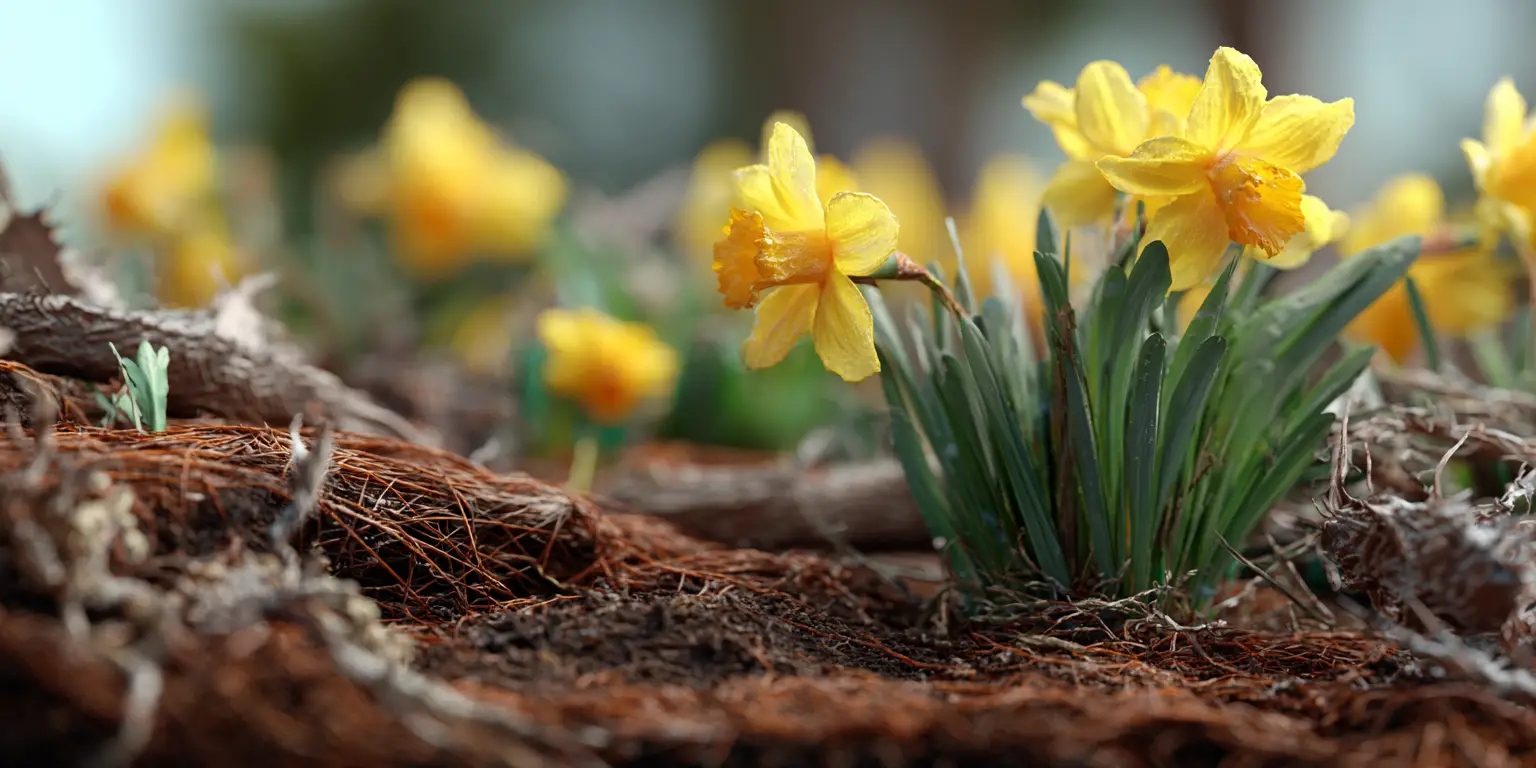
💧 Water
Daffodils have moderate water needs. During the active growing and blooming season (late winter through spring), they prefer evenly moist soil. Regular spring rainfall is usually sufficient, but in extended dry periods, a deep watering once a week will help ensure good growth and flowering. It’s important that the soil has good drainage – while daffodils like moisture during growth, they do not tolerate standing water or waterlogged soil. Overwatering in spring can lead to bulb rot, so water only as needed to keep the soil moist but not soggy.
After the flowers fade, continue to water the plants occasionally as long as the leaves are green, since the bulbs are replenishing their energy reserves for the next year. Once the foliage yellows and dies back (typically by early summer), the bulbs enter dormancy and require very little water. In fact, daffodils prefer relatively dry summer conditions. If planted in beds that are irrigated in summer, take care to avoid excessive watering. Keeping the dormant bulbs on the drier side helps prevent fungal rot. Overall, consistent moisture in spring followed by a dry rest in summer will keep daffodils healthy.
🌍 Soil and pH
Plant daffodils in soil that is well-drained and reasonably fertile. Good drainage is critical because bulbs sitting in waterlogged earth will easily rot. The ideal soil is a loamy or sandy-loam texture that stays moist in spring but never soggy. If your garden soil is heavy clay, it’s advisable to amend it with organic matter (such as compost or well-rotted leaf mold) and perhaps some coarse sand or grit to improve aeration and drainage. In very sandy soil, adding compost can help retain necessary moisture during the growing season. Daffodils are not overly fussy about soil richness – average garden soil is usually sufficient – but mixing in a bit of bulb fertilizer or compost at planting time can support their long-term health.
Regarding pH, daffodils prefer a slightly acidic to neutral soil. An optimal pH range is roughly 6.0 to 7.0. They will generally grow well in soils that fall a bit outside this range too, and some varieties tolerate mildly alkaline soil (up to around pH 7.5). If your soil is extremely acidic or highly alkaline, you may see reduced vigor or yellowing leaves due to nutrient availability issues. In most cases, though, typical garden soil pH is fine for daffodils. If unsure, a soil test can determine the pH, and amendments like lime (to raise pH) or sulfur (to lower pH) can be applied as needed to bring it into the neutral range. Ensuring the soil pH is within a reasonable range will help the plants absorb nutrients effectively.
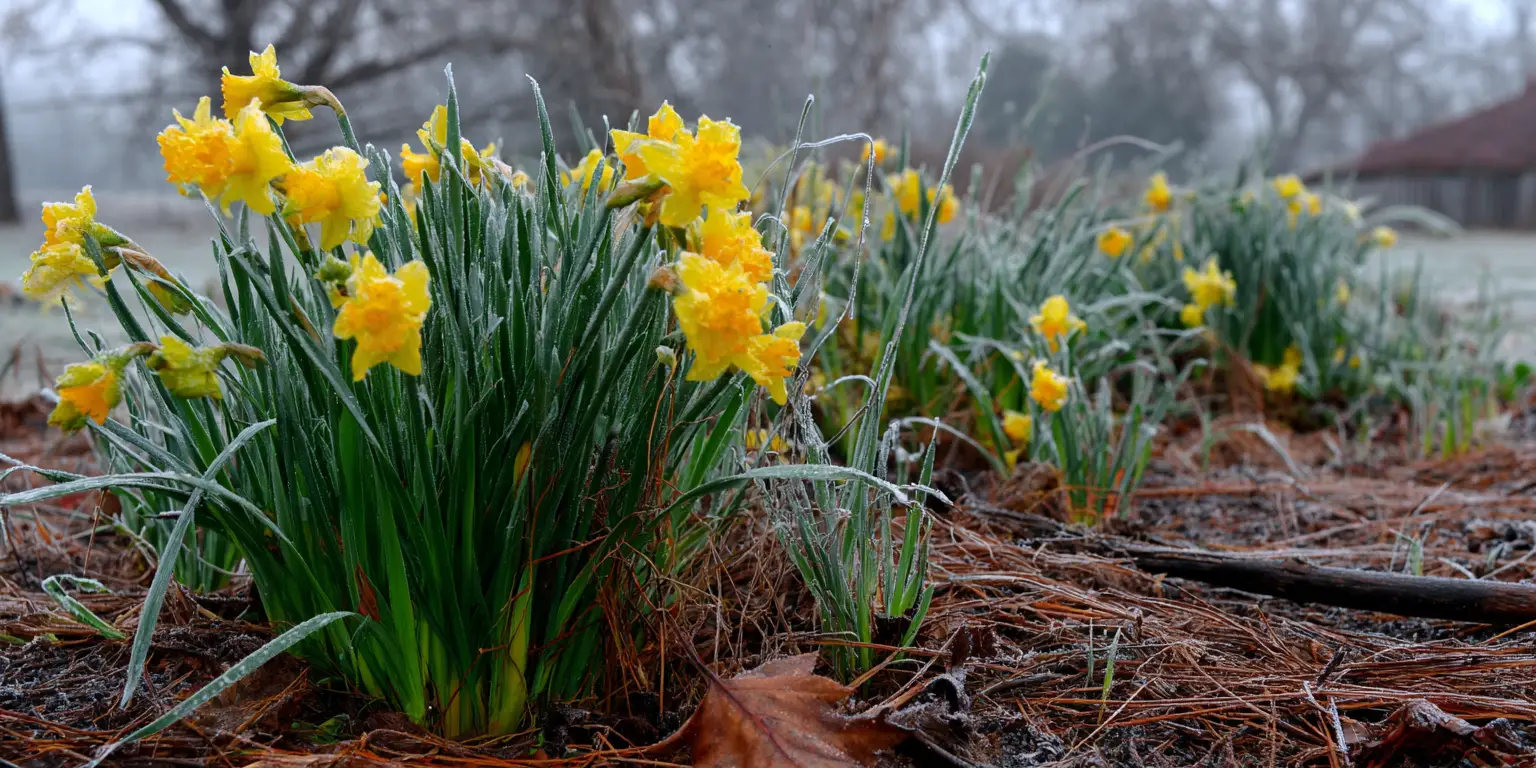
❄️ USDA hardiness
Daffodils are quite cold-hardy and are well-suited to temperate regions. Most varieties can survive winter temperatures in USDA Hardiness Zones 3 through 8, returning reliably each spring. In fact, many daffodils require a winter chill in order to bloom properly. Gardeners in colder zones (3-5) often find daffodils to be among the most dependable bulbs, as they can tolerate deep frosts and even late snow without harm. In these regions, a layer of winter snow or mulch helps insulate the bulbs, but even open-ground freezes are generally tolerated by dormant daffodil bulbs. Zones 4 to 7 are ideal for the majority of daffodil cultivars, providing the cold dormancy and moderate spring conditions that these bulbs favor.
In warmer climates, performance depends on the cultivar and winter conditions. Daffodils will grow in Zone 8 and parts of Zone 9, but very mild winters can lead to reduced flowering because the bulbs may not get enough chilling hours. Southern gardeners in zone 8-9 often select heat-tolerant or low-chill daffodil varieties (such as certain tazetta or jonquil types) that are bred to bloom with less cold. Sometimes, bulbs are pre-chilled (stored in a refrigerator for 8-10 weeks before fall planting) to simulate winter conditions. In regions warmer than Zone 9 (for example, tropical or subtropical climates), most standard daffodils will not perennialize. In those areas, daffodils are typically treated as annuals or grown in containers with artificial chilling. One notable exception is the paperwhite narcissus (a type of daffodil), which doesn’t require cold to bloom and can be grown even in warm climates, though it is usually grown indoors. Overall, for best results, daffodils should be planted in climates where they experience a cool winter dormancy.
🌼 Propagation and longevity
Daffodils naturally multiply over time, and gardeners can take advantage of this to propagate them. The primary method of propagation is by division of bulbs (also called offsets). After a few years in the ground, a healthy daffodil bulb will produce smaller bulbs attached to it. To propagate, it’s best to wait until after the plants have bloomed and the foliage has died back (usually summer or early fall). At that time, you can carefully dig up the clump of bulbs. Gently separate the bulbs, breaking apart the clusters into individual bulbs or smaller groups. Each offset that has formed can be replanted on its own, at the same depth and spacing as a new bulb. These young bulbs may take a year or two to build up enough strength to flower, but eventually they will bloom just like the original. Division not only produces more plants but also helps reinvigorate crowded clumps. It’s generally recommended to divide daffodil clumps every 5 to 10 years, or whenever you notice a decline in flowering due to overcrowding.
Daffodil bulbs are known for their longevity. In suitable conditions, they can persist and bloom for many decades. Some naturalized plantings of daffodils (for example, around old homesteads or in long-established gardens) have survived for 50 years or more with little or no care. As true perennials, daffodils will come back every year, and in fact the bulbs often increase in number annually. The key to this longevity is allowing the plants to complete their growth cycle each year – that means letting the leaves yellow and die back naturally so the bulbs can recharge. When well cared for, a planting of daffodils can essentially maintain itself, with older bulbs continually producing new offsets. Over very long periods the original bulbs may wither, but their progeny carry on. In a home garden, as long as the site remains suitable (no extreme crowding, disease, or soil exhaustion), you can expect your daffodil display to endure indefinitely, with only occasional intervention to divide and replant as needed.
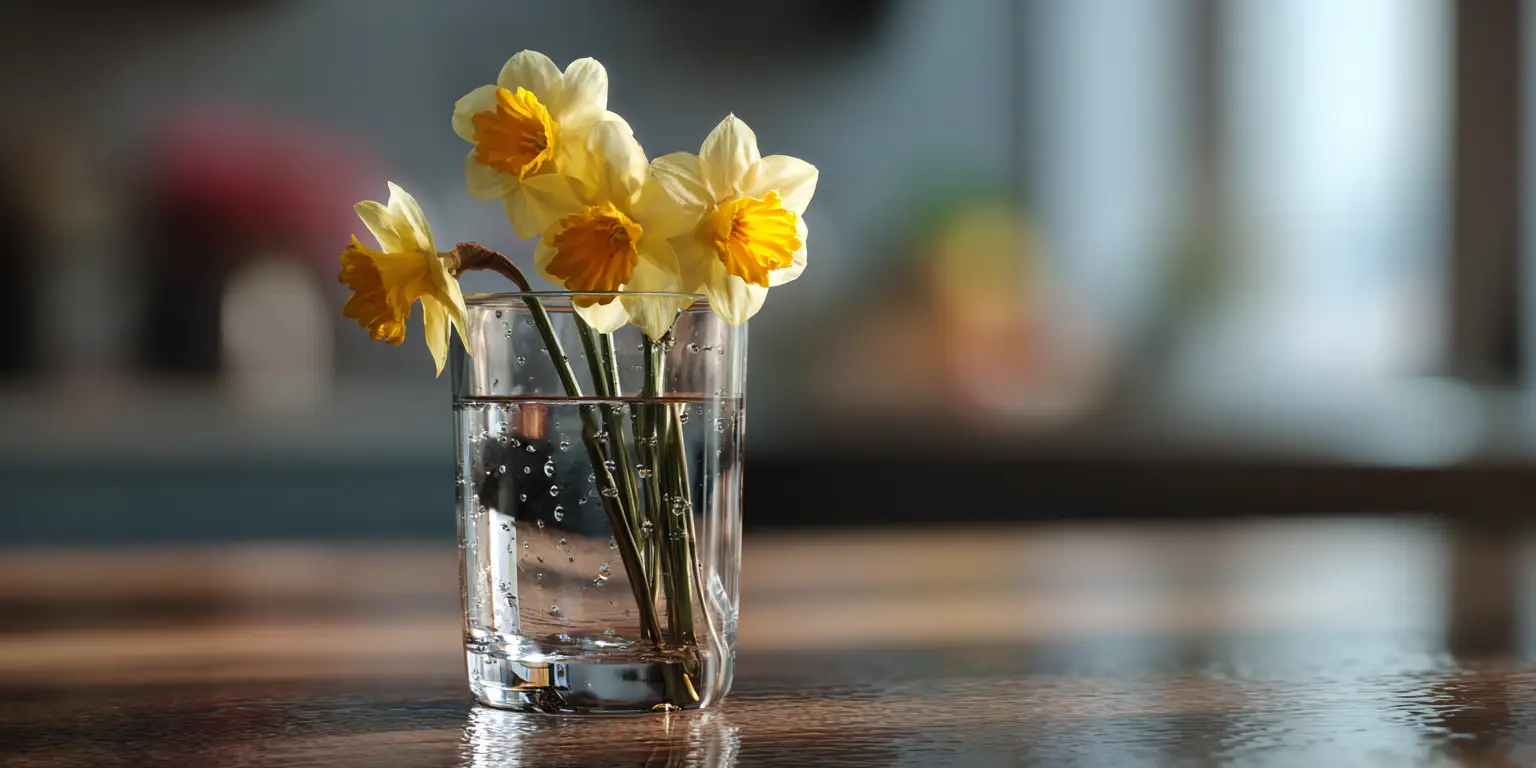
👃 Fragrance
Daffodils are not typically as strongly scented as some flowers, but many do have a pleasant fragrance if you sniff them up close. The degree of scent depends on the variety. Some daffodils have a light, honeyed or floral aroma, while others are quite perfumed. Generally, the most fragrant daffodils are those in certain groups: for example, jonquilla types (which bear several small blooms per stem) often have a sweet, jasmine-like or fruity scent. Tazetta daffodils (such as the popular paperwhites grown indoors) produce a powerful, musky-sweet fragrance that can fill a room. The poet’s daffodil (Narcissus poeticus), an heirloom type, is also renowned for its spicy, clove-like perfume. On the other hand, many of the large trumpet daffodils and modern hybrids have only a mild scent or are nearly odorless.
Gardeners who value fragrance can choose specific cultivars known for their scent. Often, bulb catalogs or plant labels will indicate fragrant varieties. It’s worth noting that individual sensitivity to daffodil fragrance varies – some people love the rich smell of paperwhite narcissus, for instance, while others find it overpowering. In the garden, planting a cluster of sweet-smelling varieties can create a gentle perfume in the spring air, especially on sunny days. And when used as cut flowers indoors, fragrant daffodils can lend a lovely scent to a room (just be careful when mixing them with other flowers, as their sap can affect companions – see “Vase life” below). Overall, while fragrance is not the primary feature of most daffodils, it is a delightful bonus in certain varieties.
⚠️ Toxicity and pet safety
All parts of the daffodil plant are poisonous to humans and animals if ingested. Daffodils contain alkaloids (such as lycorine) and other compounds that can cause significant gastrointestinal upset and other symptoms. The bulbs are the most toxic part (often mistaken for onions with dangerous results), but even the leaves and flowers can cause issues if eaten. In humans, consuming daffodils or drinking the water from a vase of daffodils can lead to nausea, vomiting, abdominal pain, and diarrhea, larger quantities may cause dizziness, convulsions, or more serious effects. Therefore, it’s crucial to keep daffodil bulbs out of reach of children and ensure no one attempts to use any part of the plant for edible purposes. For the same reasons, never use daffodil stems or bulbs in cooking or as a “natural remedy” – their toxicity makes them unsafe for ingestion.
When it comes to pets, daffodils are considered unsafe for cats, dogs, and horses. If a pet digs up and chews on a daffodil bulb (or occasionally even samples a flower or leaves), it can result in drooling, vomiting, diarrhea, and lethargy. In severe cases, ingestion can lead to tremors, low blood pressure, or heart irregularities. Pet owners should be careful about where they plant daffodil bulbs, avoiding locations that pets commonly dig. Also take care with cut daffodils in arrangements – curious cats might be tempted to nibble the flowers or drink the vase water, which can also cause illness. If you suspect a pet has ingested parts of a daffodil, contact a veterinarian promptly.
Even handling daffodils can pose minor risks: the sap in daffodil stems and bulbs contains sharp calcium oxalate crystals that can irritate the skin. Gardeners or florists who frequently handle daffodils sometimes develop “daffodil itch,” a contact dermatitis that causes redness, itching, or blistering on the skin. Wearing gloves when planting bulbs or trimming daffodils, and washing hands after contact, can prevent this irritation.
On the positive side, daffodils’ toxicity has an upside in the garden – it makes them unappealing to wildlife and pests. Deer, rabbits, and squirrels, which often graze on tulips or other flower bulbs, tend to leave daffodils alone. The same poisonous compounds that protect the plant from being eaten by animals are what gardeners count on to make daffodils a reliably animal-resistant flower. So, while daffodils must be handled with care around people and pets, they are generally a safe choice for gardens in terms of pest protection.
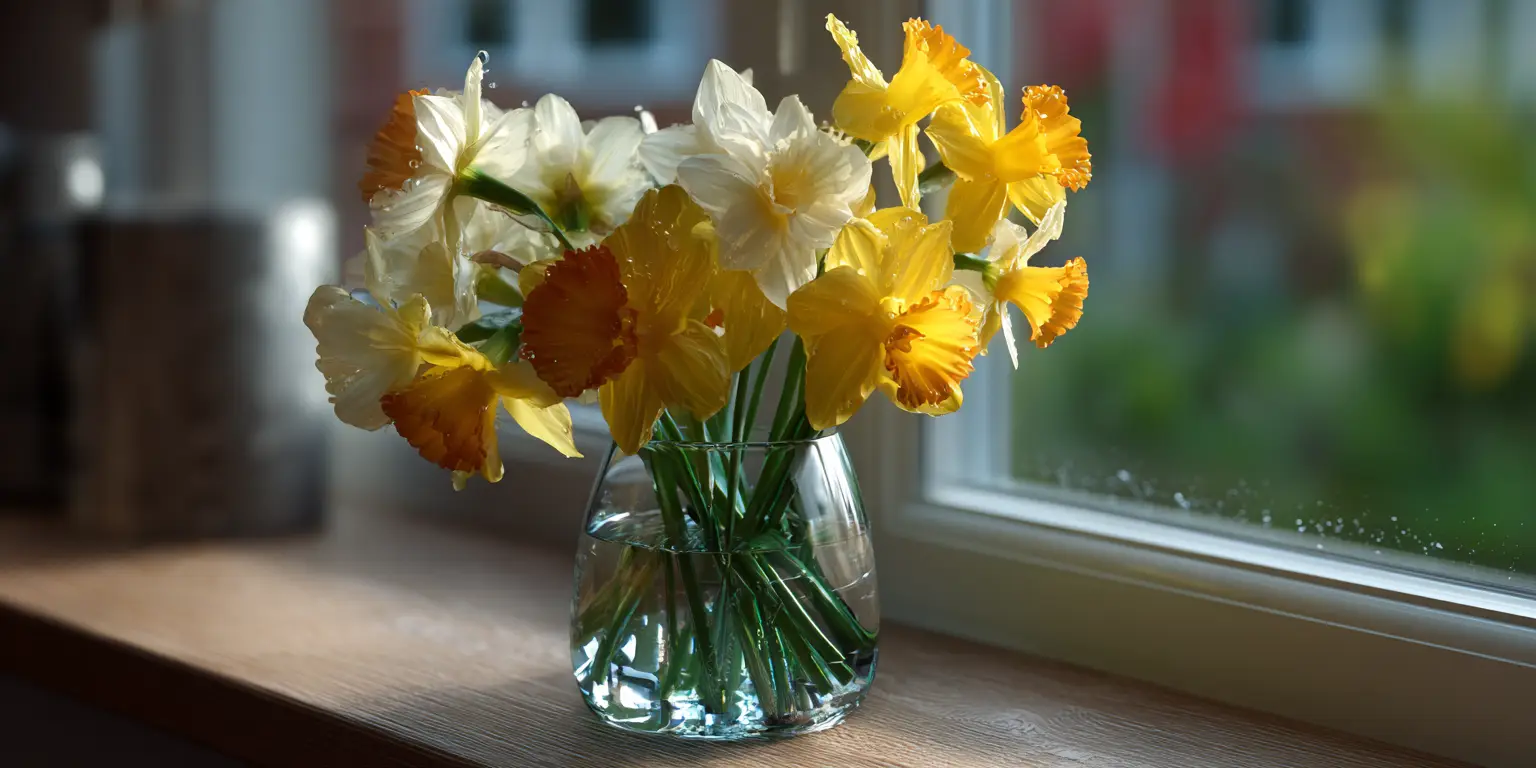
🌿 Vase life
Fresh-cut daffodils generally have a moderate vase life, lasting around 5 to 7 days under good conditions. For the longest-lasting display, cut the stems when the buds are just starting to show color but haven’t fully opened (often called the “gooseneck” stage). Use clean, sharp pruners or a knife to make a diagonal cut on the stems. One important thing to know about daffodils as cut flowers is that their stems exude a sticky, sap-like juice after cutting. This sap can be problematic if you plan to mix daffodils with other flowers, because it contains compounds that can cause other flowers to wilt faster. Florists typically avoid immediately arranging freshly cut daffodils with more delicate blooms due to this issue.
To enjoy daffodils in mixed bouquets, a simple technique is used: conditioning. Place the freshly cut daffodil stems in a separate container of cool water by themselves for several hours (at least 2-3 hours, or overnight). This allows much of the sap to drain out. After conditioning, you can carefully combine the daffodils with other flowers in an arrangement – just do not recut the daffodil stems again, or else more sap will release. Some people prefer to keep daffodils in their own vase to be safe, but if mixed properly, they can sit with other spring blooms (like tulips or irises) for a short time. In any case, maintain your vase of daffodils by refreshing the water daily or every other day, and keep the arrangement in a cool spot away from direct heat or sunlight. Using a floral preservative in the water may also extend the freshness. With these steps, cut daffodils can brighten an indoor space for nearly a week with their vibrant colors.
🐛 Pests and diseases
In general, daffodils are among the least troubled garden plants, thanks in part to their toxic alkaloids that deter many pests. Deer and rodents, as mentioned, rarely feed on them. However, daffodils do have a few specialized pests and disease issues to watch for. One insect that can cause damage is the narcissus bulb fly (also called large bulb fly). This bumblebee-like fly lays eggs near daffodil bulbs in summer, the resulting larvae burrow into the bulbs and devour them from the inside. An infested bulb often fails to grow or produces only weak, yellow foliage. Unfortunately, once a bulb is infested, it usually must be dug up and discarded. Preventive measures include avoiding leaving dug bulbs out in the open (which attracts the flies) and promptly removing any bulbs that appear diseased or rotted. Smaller pests like bulb mites and nematodes can also infest bulbs, especially if bulbs are stored improperly or the soil is excessively wet. These microscopic pests can cause bulbs to rot or foliage to become distorted. Good sanitation and crop rotation can help prevent their buildup.
Daffodils can occasionally suffer from fungal diseases, particularly in wet conditions. The most notorious is basal rot (caused by a fungus, often Fusarium species), which attacks the bulb’s basal plate. Bulbs afflicted by basal rot may show pinkish or brown decay at their base and will either not sprout or will send up stunted, yellowed leaves that quickly wither. There is no cure for a rotting bulb – it should be removed and destroyed, and it’s wise not to replant new daffodil bulbs in the exact same spot for a couple of years to let the fungus die out. Another fungal issue is botrytis blight (sometimes nicknamed “daffodil fire”), which can cause brown spots on leaves and flowers followed by a gray, fuzzy mold in prolonged damp weather. If botrytis appears, remove and dispose of the infected plant parts (do not compost them) to limit the spread. Viral diseases can also affect daffodils, signs include yellow streaks or mottling on leaves, deformed flowers, or a general decline in vigor. Viruses are incurable, so infected plants and bulbs should be discarded to prevent them from spreading (aphids often transmit these viruses). The best strategy to avoid diseases is to plant healthy bulbs in well-drained soil, avoid overwatering, and ensure adequate spacing for air circulation. By following good cultural practices – and because daffodils are naturally resilient – most gardeners will find their daffodil plantings remain largely pest- and disease-free.
FAQs
How and when should I plant daffodil bulbs?
Plant daffodil bulbs in the fall, ideally about 2 to 4 weeks before the ground freezes in your area. In cooler climates (zones 3-6) this might be September or October, in warmer climates (zones 7-9), October or November is often best. Choose a sunny spot with well-drained soil. Dig a hole about 6 inches (15 cm) deep for standard-size bulbs (smaller bulbs can be planted 4-5 inches deep). Place the bulb pointed end up (root side down) and cover it with soil. Space bulbs about 4-6 inches apart. Water them in after planting to help settle the soil. They will stay dormant through winter and then sprout and bloom in the spring.
Do daffodils come back every year and do they multiply on their own?
Yes, daffodils are perennial bulbs that will return each year. In fact, they often multiply naturally over time. Each bulb can produce “offset” bulblets that will grow into flowering bulbs in a couple of years. With good growing conditions (sun, moisture, and time to recharge after bloom), a planting of daffodils will not only come back every spring, but the clumps will get larger as the bulbs divide themselves. It’s one reason daffodils are beloved for naturalizing – they tend to spread and create bigger displays each year with little intervention.
Why did my daffodils not bloom (or stop blooming)?
If your daffodils produced leaves but no flowers (sometimes called “blind” daffodils), several factors could be at play. The most common reasons are lack of sunlight (for example, if they’re now in deep shade under growing trees) or the bulbs being too crowded after years of multiplying (which means they compete for nutrients). Another possibility is that the foliage was cut back too early the previous year, so the bulbs didn’t get enough energy stored. Daffodils also need a cold winter dormancy – in very mild climates they might not bloom well unless pre-chilled. Less commonly, nutrient depletion or bulb disease can cause lack of blooms. Try to address these issues by ensuring they get enough sun, dividing overcrowded clumps in summer, leaving the leaves to die back naturally, and perhaps adding some bulb fertilizer after flowering. With the right conditions restored, they should resume blooming.
What’s the difference between daffodils, narcissus, and jonquils?
These terms can be confusing because they’re related. Botanically, all daffodils are Narcissus – that’s the Latin genus name for the group of plants. “Daffodil” is the common English name referring to any flower in the Narcissus genus (especially the large trumpet types). “Jonquil” traditionally refers to a specific species, Narcissus jonquilla, and its hybrids, which have multiple small fragrant flowers and reed-like leaves. However, in some regions (like the American South), people say “jonquils” to mean any daffodils. Essentially, daffodil and narcissus are interchangeable general terms (narcissus tends to be used more in scientific or poetic contexts), while jonquil is a narrower category of daffodil. When you buy daffodil bulbs, you might see them labeled as “narcissus” – but they’re the same plant.
Can I grow daffodils in pots or indoors?
Yes, daffodils can be grown in containers, and certain varieties can even be “forced” to bloom indoors out of season. For outdoor patio pots, plant the bulbs in the fall just as you would in the ground (at the appropriate depth, in well-draining potting mix). Use a sufficiently deep pot to allow room for root growth and winter protection for the bulbs, and keep the soil moist (but not waterlogged) through winter. The bulbs will sprout and bloom in spring in the pot. For indoor forcing, choose a variety suited for forcing (paperwhites are a popular choice since they don’t require chilling, other daffodils will need a cold period). Plant the bulbs in potting mix or even just pebbles with water (for paperwhites), and give them a cold treatment (around 40°F/4°C) for about 8-12 weeks if they are a type that needs chilling. After the chilling period (which can be done in a refrigerator or unheated garage), bring them into a cool, bright room to sprout and bloom. With proper timing, you can have daffodils blooming indoors in winter. Just remember that forced bulbs often won’t have the energy to bloom again immediately, so they are typically planted outdoors to recover or discarded after forcing.
What should I do with daffodils after they finish blooming?
After daffodils bloom, it’s best to remove the spent flower heads (a practice known as deadheading). This prevents the plant from putting energy into seed production. However, do not cut down or tie up the green leaves – those leaves need to continue photosynthesizing to recharge the bulb for next year. Leave the foliage in place and let it grow until it naturally yellows and withers, which usually takes about 4-6 weeks after flowering. During this period, you can optionally give the plants a little balanced fertilizer or compost to help build up the bulbs. Once the leaves have turned yellow/brown and come away easily, you can clear them. If your bulbs are very crowded or you want to move them, the period after the foliage dies back (or early fall before the ground freezes) is a good time to dig up and divide/replant daffodil bulbs. Otherwise, you can simply leave the bulbs in the ground to come up again next spring.
Are daffodils deer-proof and pest resistant?
Yes – one of the great advantages of daffodils is that they are generally deer-proof and rodent-proof. Animals tend to leave them alone. The reason is that daffodil bulbs and leaves contain toxic chemicals (alkaloids) that taste bad and can make animals sick, so creatures like deer, rabbits, voles, and squirrels instinctively avoid eating them. This means you can plant daffodils in areas frequented by wildlife and expect the bulbs to remain undisturbed (whereas something like tulips often gets eaten). Keep in mind, while animals won’t eat daffodils, sometimes a curious squirrel might dig up newly planted bulbs – not to consume them, but out of curiosity – so it can help to cover freshly planted areas with some mulch or even mesh until the ground settles. In terms of insect pests, daffodils also have relatively few issues (as discussed above, only specialized pests like bulb flies or certain mites might bother them). So, daffodils are considered one of the more pest-resistant flowers for gardens.
Interesting tips
- According to Greek mythology, the first daffodil (narcissus) sprang from the spot where a beautiful youth named Narcissus died after becoming entranced by his own reflection. This legend is how the flower and genus got its name.
- Daffodils symbolize rebirth and new beginnings, since they emerge at winter’s end. Fittingly, they are the birth flower for the month of March. The daffodil is also used as a symbol of hope by cancer awareness organizations in many countries (e.g. “Daffodil Day” fundraisers).
- There are over 25,000 named daffodil cultivars registered worldwide, with new ones introduced each year. To help gardeners navigate this variety, daffodils are classified into 13 divisions based on their floral form and heritage (such as trumpet, large-cup, small-cup, double, triandrus, jonquilla, tazetta, poeticus, etc.).
- The daffodil is the traditional flower for the 10th wedding anniversary. Its bright, enduring blooms represent the joy and happiness of a decade of marriage.
- Folklore says you should always display daffodils in a bunch – never a single flower alone. A solitary daffodil is thought to bring misfortune, while a cluster of daffodils is said to bring good luck and prosperity.